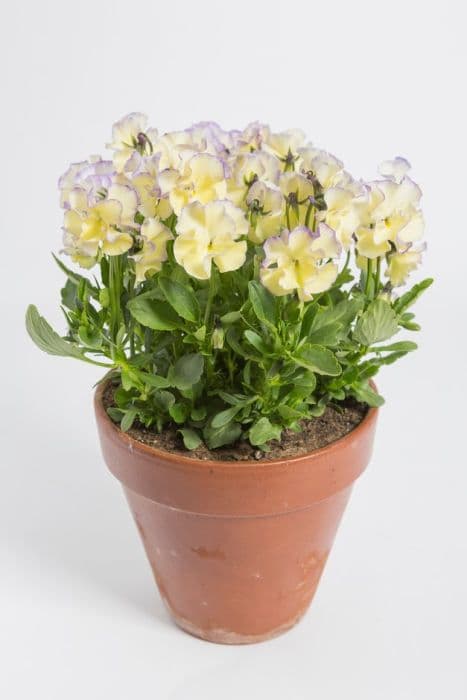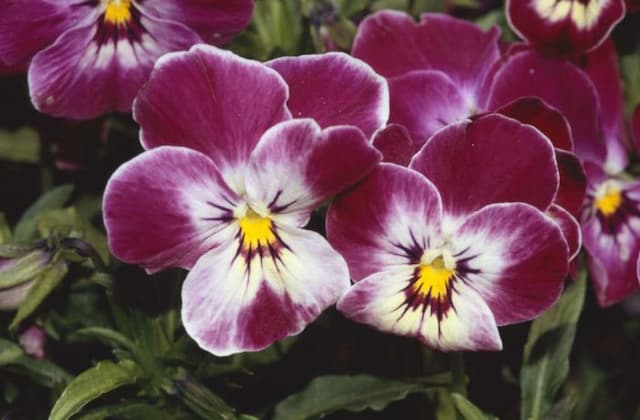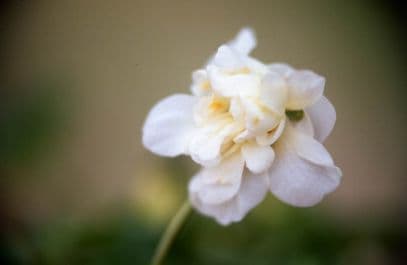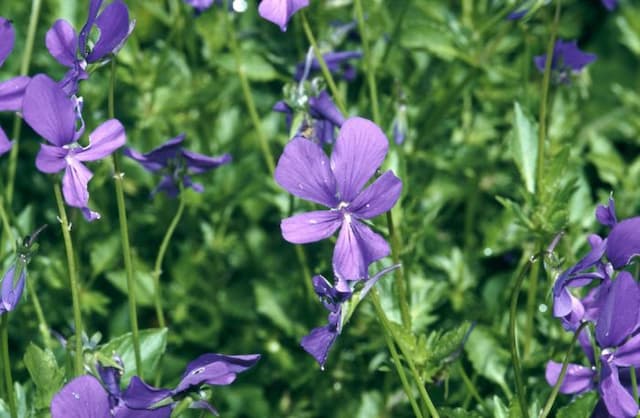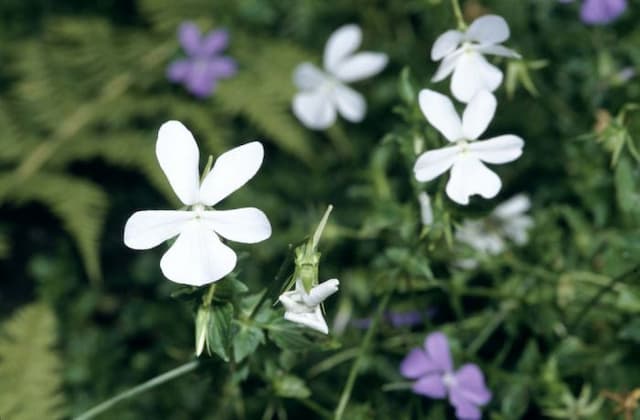Pansy Viola 'Rebecca' (Vtta)

ABOUT
Viola 'Rebecca' is a charming flowering plant distinguished by its unique blooms. The flowers are a delightful blend of color, predominantly creamy yellow with delicate lavender edges that can give a soft, pastel appearance to the bloom. Each petal is softly rounded, contributing to a gentle overall shape for the flowers. The petals may also feature faint whisker-like markings that lead into the center of the bloom, adding an intricate aspect to its appearance. The flowers are presented amidst a backdrop of green foliage, with leaves that typically have a soft, slightly ruffled texture, adding to the plant's lushness. The combination of vibrant flowers and verdant leaves makes Viola 'Rebecca' a standout in any garden setting, known for its ability to provide a splash of color and interest.
About this plant
 Names
NamesSynonyms
Rebecca Violet, Horned Violet, Tufted Violet
Common names
Viola 'Rebecca' (Vtta).
 Toxicity
ToxicityTo humans
The common name for Viola 'Rebecca' is violet. In general, violets are not considered toxic to humans. In fact, some species of violet are edible and are often used in salads, as a garnish, or candied as a decoration for desserts. However, it is essential to be certain of the specific type and species before ingestion, as there are many plants with similar appearances. For plants not confirmed to be safe, it is best to err on the side of caution and avoid ingestion to prevent potential adverse effects. If a person were to ingest part of a violet plant that is not known to be safe for consumption, and if that specific plant were toxic, symptoms could include mild gastrointestinal upset, such as nausea, vomiting, or diarrhea.
To pets
The common name for Viola 'Rebecca' is violet. Violets are typically considered non-toxic to pets, including cats and dogs. They are generally safe for pets to be around, and ingestion of violet flowers or leaves typically does not lead to serious illness. However, as with humans, it is important to know whether the specific type of violet is safe, as other plants may resemble violets and could be harmful. If a pet were to ingest a toxic plant mistaken for a violet, symptoms of poisoning could vary depending on the plant ingested and could range from gastrointestinal upset to more severe issues such as damage to the liver or kidneys, but this is not common with true violets. It's always prudent to supervise pets in gardens or areas with various plants and to consult a veterinarian if you suspect your pet has ingested something potentially harmful.
 Characteristics
CharacteristicsLife cycle
Perennials
Foliage type
Evergreen
Color of leaves
Green
Flower color
Mixed
Height
6 inches (15 cm)
Spread
10 inches (25 cm)
Plant type
Herb
Hardiness zones
Varies
Native area
Europe
Benefits
 General Benefits
General Benefits- Ornamental Value: Viola 'Rebecca' is known for its beautiful, distinctive flowers that add aesthetic appeal to gardens and landscapes.
- Extended Bloom Time: This plant often has a long flowering season, bringing color to gardens from spring into fall.
- Easy to Grow: It is generally considered easy to care for and does not require complex gardening skills.
- Drought Tolerance: Once established, the plant can be quite tolerant to periods of low water, making it suitable for various climates.
- Pest Resistance: Viola 'Rebecca' may have natural resistance to common garden pests, requiring less pesticide usage.
- Attracts Wildlife: The flowers can attract pollinators like bees and butterflies, which are beneficial for the garden ecosystem.
 Medical Properties
Medical PropertiesThis plant is not used for medical purposes.
 Air-purifying Qualities
Air-purifying QualitiesThis plant is not specifically known for air purifying qualities.
 Other Uses
Other Uses- Viola 'Rebecca' can be used in pressed flower art, as their colorful petals retain color well when dried and pressed, making them ideal for creating natural, floral artwork.
- Edible decoration for pastries, as their flowers are not only edible but can add a unique aesthetic to cakes and desserts when candied or used fresh.
- Seasonal markers in gardening, their flowering time in spring can help gardeners recognize the transition between cold and warm seasons for planting and soil preparation tasks.
- Photography subjects due to their striking colors and patterns, making them suitable for botanical photography and helping hobbyists to practice macro photography techniques.
- Crafting natural dyes as the petals of Viola 'Rebecca' can be used to create dyes for fabric, yarns, and paper, resulting in soft pastel colors.
- Adding to salads for a colorful and slightly sweet addition, their petals can provide a visual upgrade to green salads or fruit salads.
- Homemade potpourri, as the dried flowers can be mixed with other dried plants and essential oils to create natural and fragrant blends for a home.
- Teaching tool in schools to help children learn about plant biology, pollination, and the lifecycle of plants through observation and care of this easily-grown viola.
- Creating a habitat for beneficial insects, such as bees and butterflies, which are attracted to their flowers and can help in the pollination of nearby plants.
- Herbal infusions for a gentle, floral tea, remembering to ensure all plants used are free of pesticides and other chemicals prior to consumption.
Interesting Facts
 Feng Shui
Feng ShuiThe plant_name is not used in Feng Shui practice.
 Zodiac Sign Compitability
Zodiac Sign CompitabilityThe plant_name is not used in astrology practice.
 Plant Symbolism
Plant Symbolism- Modesty: Violas are often associated with humility and modesty due to their small and unassuming flowers that don't demand attention.
- Innocence: The delicate and simple appearance of violas can symbolize innocence or purity in various cultural contexts.
- Illumination: Violas in light shades, like Viola 'Rebecca', might symbolize the idea of light or spiritual illumination, reflecting their bright colors that stand out in the garden.
- Love: In the language of flowers, violas can represent the sentiment of love, particularly young love or a love that is delicate and tender.
- Faithfulness: Due to their perennial nature, returning year after year, violas can be a symbol of faithfulness and enduring affection.
- Remembrance: Violas, similar to pansies, can signify remembrance or thoughts occupied by a loved one, as they were often used in Victorian times to convey messages without words.
 Water
WaterPansies, including the Viola 'Rebecca', should be watered thoroughly and consistently to maintain moist but not waterlogged soil. Typically, watering every few days should be sufficient, though this may vary based on climate conditions, with an approximate amount of 1 gallon per square foot every week during active growth periods. In hotter, drier periods, they may require water more frequently. It's important to avoid overhead watering if possible to prevent fungal diseases; instead, water at the base of the plant. During the winter or cooler months, reduce watering as the plant's growth slows down.
 Light
LightPansies, like the Viola 'Rebecca', thrive in full to partial sunlight. The ideal spot is one where they can receive morning sun and afternoon shade, especially in hotter climates, as this will help prevent the flowers from fading and reduce stress on the plant. In cooler climates, they can tolerate more sun throughout the day.
 Temperature
TemperaturePansies, such as the Viola 'Rebecca', prefer cooler temperatures with the ideal range being between 40 and 60 degrees Fahrenheit. They can survive light frosts and temperatures down to about 20 degrees Fahrenheit but will start to suffer if temperatures exceed 80 degrees Fahrenheit. These plants are known for their ability to thrive in the cooler months and even bloom again once temperatures drop in the fall.
 Pruning
PruningFor pansies such as the Viola 'Rebecca', regular deadheading, or removing spent flowers, helps to encourage more blooms and maintain a tidy appearance. Pruning should be done as needed throughout the blooming season to remove faded or dead flowers. The best time for more extensive pruning or cutting back is in late winter or early spring to rejuvenate the plants for the upcoming growing season.
 Cleaning
CleaningAs needed
 Soil
SoilFor the Pansy 'Rebecca', a well-draining, fertile soil with a pH range of 5.4 to 5.8 is ideal. A balanced mix of peat, loam, and sand enriched with organic matter such as compost will promote healthy growth. Ensure adequate drainage to prevent waterlogging.
 Repotting
RepottingPansies, including 'Rebecca', generally do not need frequent repotting and can often last in the same container for a season. Repot only if the plant outgrows its container or the soil becomes exhausted, typically every 1-2 years.
 Humidity & Misting
Humidity & MistingPansies like 'Rebecca' prefer average humidity levels. They are adaptable but thrive in outdoor conditions where humidity is naturally regulated without the need for specific interventions.
 Suitable locations
Suitable locationsIndoor
Place in bright, indirect light and keep soil moist.
Outdoor
Plant in partial shade, ensure well-drained soil, water regularly.
Hardiness zone
6-10 USDA
 Life cycle
Life cycleViola 'Rebecca', commonly known as Rebecca Violet, begins its life cycle as a seed which germinates when exposed to the right conditions of moisture and temperature, typically in spring or autumn. The seeds develop into seedlings with a rosette of leaves close to the soil surface. As it matures, Rebecca Violet grows into a compact plant with a display of flowers that are often bi-colored or have intricate patterns, usually blooming from early spring to late autumn. After pollination, often by insects or through self-fertilizing, the plant produces a fruit capsule containing seeds that are dispersed by various means, including wind and rain splash. Throughout its life, the plant goes through vegetative and floral growth cycles annually, often dying back in the winter to re-emerge from its rootstock the following spring. The plant may also spread asexually through stolons or division of the clump, allowing new clones to establish nearby.
 Propogation
PropogationPropogation time
Spring-Early Summer
Propogation: The Viola 'Rebecca', commonly known as Rebecca Violet, is typically propagated through division, which is best done in the spring or fall. To propagate by division, carefully dig up the plant and gently separate the clumps of roots into smaller sections, ensuring that each new section has a portion of the root system and several shoots. Replant each new section at the same depth it was growing at previously, and water well. This method maintains the characteristics of the original plant and allows for quick establishment in the garden. It is important to handle the roots with care to minimize damage and to give the new plants ample water until they are established.
